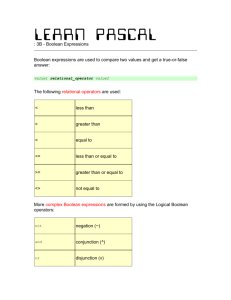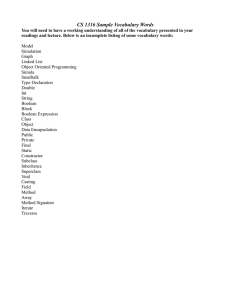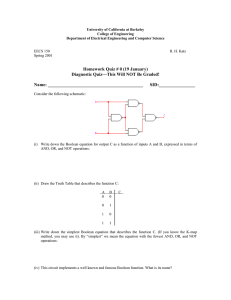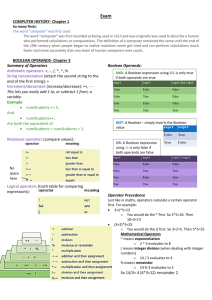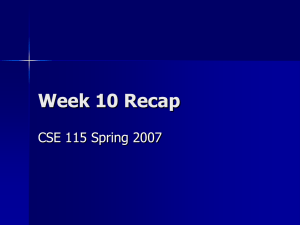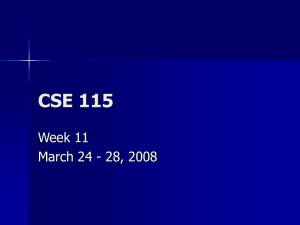CS1001 Lecture 15 1
advertisement
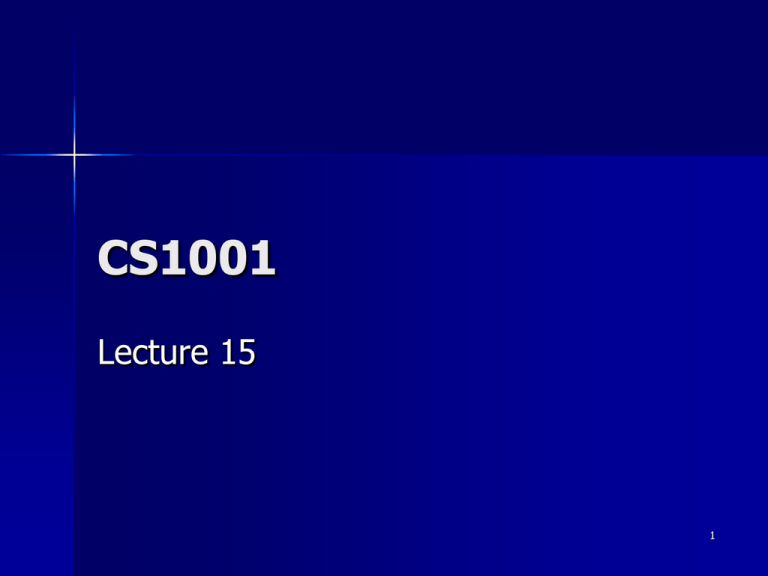
CS1001
Lecture 15
1
Overview
Java Programming
Arrays
2
Goals
Understand the basics of Java
programming
Control Statements and Arrays
3
Assignments
Brookshear: Ch 4, Ch 5 (Read)
Read linked documents on these slides
(slides will be posted in courseworks)
http://java.sun.com/docs/books/tutorial/
4
Objectives:
Learn about the boolean data type
Learn the syntax for if-else statements
Learn about relational and logical operators, De
Morgan’s laws, short-circuit evaluation
Learn when to use nested if-else statements, ifelse-if sequences, the switch statement
5
Midterm
History – Know people and the point of their
contributions. Be prepared for short answers (2-3
sentences)
Hardware – Know the main parts of a computer
(processor, memory, etc). Understand that
programs and data are both information and can be
stored in some sort of memory.
Assembly – given a simple assembly language,
write a short (very short) program
Problem solving – identify a problem with a given
algorithm
6
Midterm
Networking: TCP vs UDP
Good/bad design features: be able to name
a few usability features
Modern architecture: privacy, centralization
(references on review sheet)
Programming: given program x, what does
it output when run?
Find the error (not syntax errors; logic
errors only)
7
if-else Statement
if ( <condition> )
{
< statements >
}
else
{
< other statements >
}
if ( <condition> )
{
< statements >
}
else clause
is optional
8
boolean Data Type
George Boole (1815 - 1864)
Unified Logic and Mathematics
boolean variables may have
only two values, true or false.
You define boolean fields or
boolean local variables the
same way as other variables:
Reserved
words
boolean
true
false
private boolean hasMiddleName;
boolean isRolling = false;
9
Boolean Expressions
In if (<condition> ) <condition> is a
Boolean expression.
A Boolean expression evaluates to either
true or false.
Boolean expressions are written using
boolean variables and relational and logical
operators.
10
Relational Operators
<, >, <=, >=, ==, !=
is equal to
is NOT
equal to
11
Relational Operators
(cont’d)
Apply to numbers or chars:
if ( x <= y ) ...
if ( a != 0 ) ...
if ( letter == ‘Y’ ) ...
Do not use == or != with
doubles because they may
have rounding errors
double x = 7.0;
double y = 3.5;
if (x / y == 2.0)
...
May be
false!
12
Relational Operators
(cont’d)
Be careful using == and != with objects
(e.g., Strings): they compare references
(addresses) rather than values (the
contents)
String cmd = console.readLine();
if ( cmd == "Help" ) ...
Wrong!
(always false)
13
Relational Operators
(cont’d)
Use the equals method to compare Strings:
String cmd = console.readLine();
if ( cmd.equals ("Help") ) ...
or
if ( "Help".equals (cmd) ) ...
14
Relational Operators
(cont’d)
Use the == or != operator with strings and
other objects when you want to know
whether or not this is exactly the same
object.
Also use == or != to compare to null:
String text = file.readLine();
if ( text != null ) ...
15
Logical Operators
&&,
||,
!
and
or
not
16
Logical Operators (cont’d)
( condition1 && condition2 ) is true if
and only if both condition1 and
condition2 are true
( condition1 || condition2 ) is true if and
only if condition1 or condition2 (or both)
are true
!condition1 is true if and only if
condition1 is false
17
Logical Operators (cont’d)
&&, ||, and ! obey the laws of formal
logic called De Morgan's laws:
! (p && q)
==
( !p || !q )
! (p || q)
== ( !p && !q )
Example:
if ( ! ( x => -10 && x <= 10 ) ) ...
if ( x < -10 || x > 10 ) ...
Easier to read
18
Ranks of Operators
!
-(unary)
*
/
+
-
<
<=
++
-- (cast)
%
>
>=
==
!=
&&
||
Easier to read
if ( ( ( year % 4 ) == 0 ) && ( month == 2 ) ) ...
if ( year % 4 == 0 && month == 2 ) ...
19
Short-Circuit Evaluation
if (condition1 && condition2) ...
If condition1 is false, condition2 is not evaluated
(the result is false anyway)
if (condition1 || condition2) ...
If condition1 is true, condition2 is not evaluated
(the result is true anyway)
if ( x >= 0 && Math.sqrt (x) < 15.0) ...
Always OK: won’t get to sqrt if x < 0
20
Nested if-else
if ("forward".equals(cmd))
{
if (slide >= numSlides)
beep.play();
else
slide++;
}
else
{
if (slide <= 1)
beep.play();
else
slide--;
}
21
if-else-if
if (drinkSize.equals(”Large"))
{
price += 1.39;
}
else if (drinkSize.equals("Medium"))
{
price += 1.19;
}
else // if "Small" drink size
{
price += 0.99;
}
22
Common if-else Errors
if (...) ;
{
statements;
...
}
Extra
semicolon
if (...)
statement1;
statement2;
...
Missing braces
if (...)
if (...)
It is safer
to always
use braces
in if-else
statement1;
else
statement2;
...
23
The switch
Statement
Reserved
words
switch (expression)
{
case value1:
...
break;
switch
case
default
break
}
case value2:
...
break;
...
...
default:
...
break;
Don’t
forget
breaks!
24
The Craps Applet
25
Review:
What are the possible values of a boolean
variable?
What operators are used to compare
values of numbers and chars?
How can you test whether two Strings
have the same values?
Which binary operators have higher rank
(are executed first), relational or logical?
26
Review (cont’d):
Can you have an if statement without an
else?
What are De Morgan’s laws?
Explain short-circuit evaluation.
How long can an if-else-if sequence be?
What are breaks used for in switch? What
happens if you forget one?
Can the same case in a switch have two
breaks?
27

